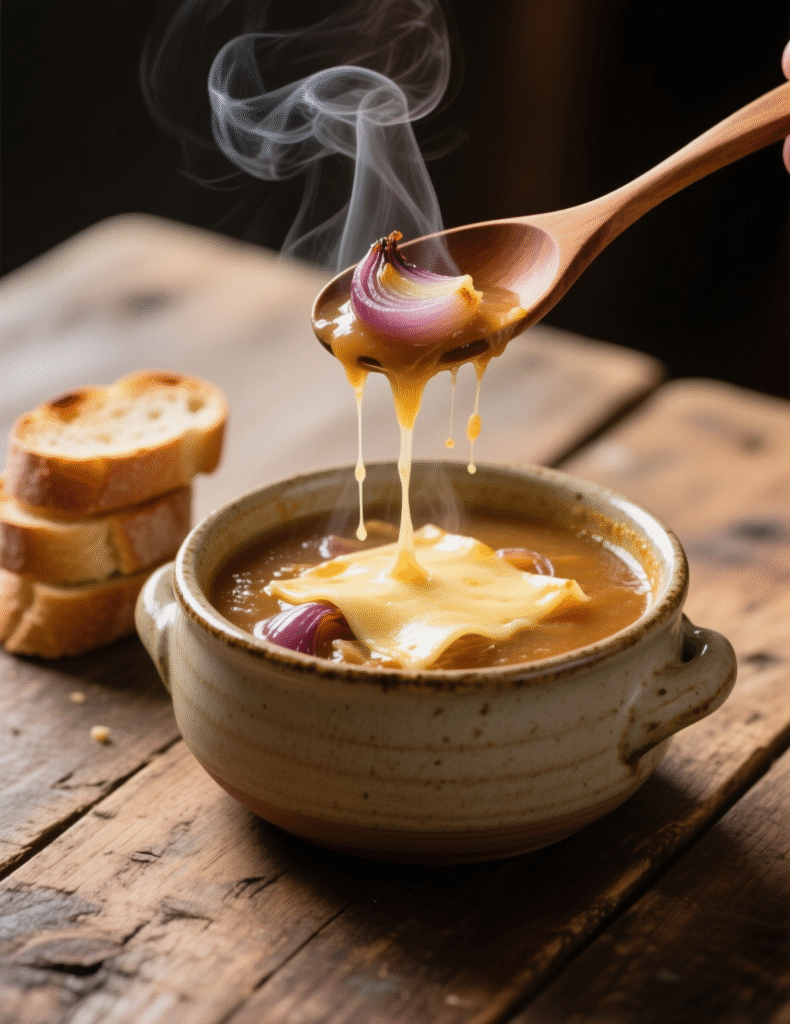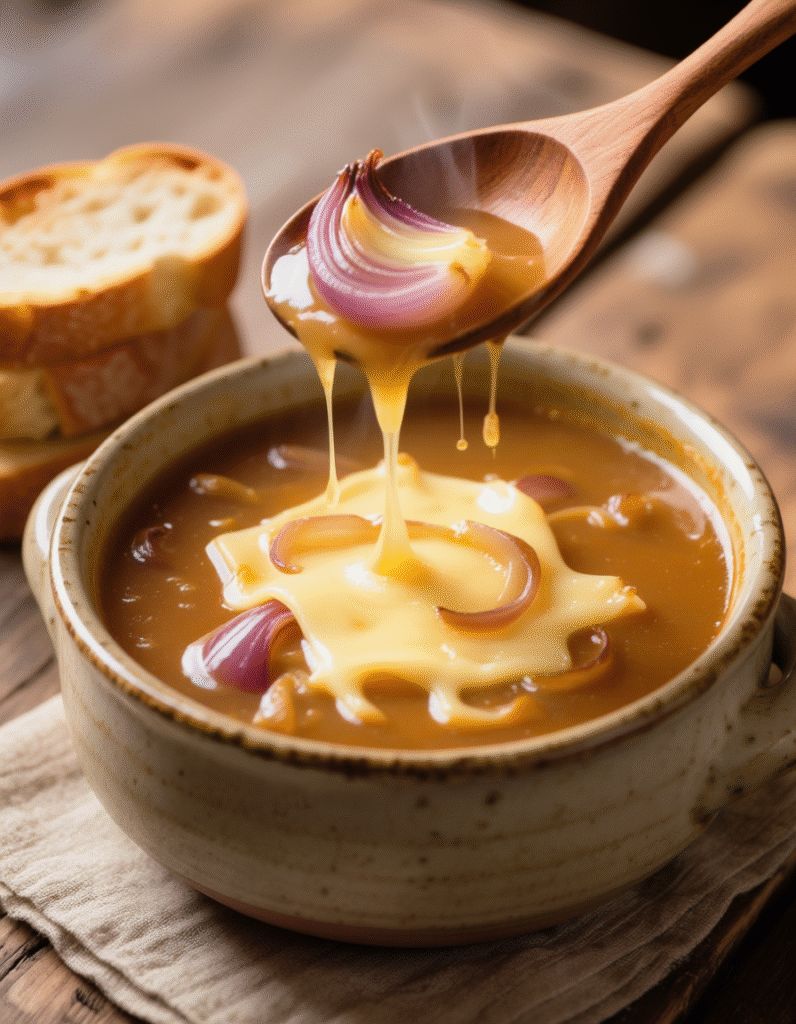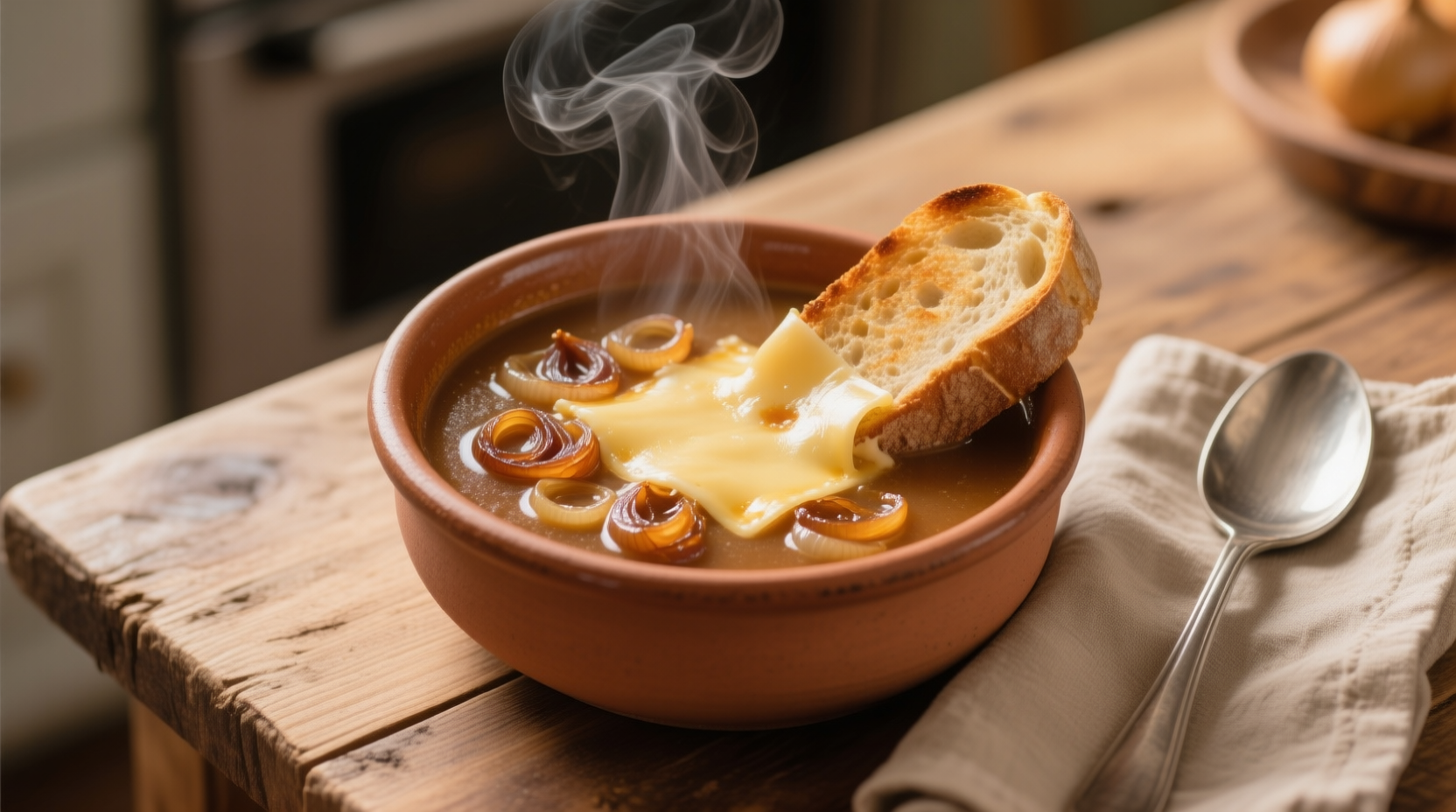French onion soup might be one of the most deceptive dishes in the culinary world. It looks so simple—onions, stock, bread, cheese. But every chef who has tried knows the truth: making it sing requires patience, balance, and a respect for time. When you bring the crockpot into the mix, the whole process changes. What you get is something almost impossible to achieve on the stovetop—onions that caramelize with minimal fuss, layers of sweetness that build naturally, and a broth so comforting you’ll forget how long it actually took.
This article isn’t just about showing you the recipe. It’s about understanding the technique behind crockpot French onion soup, why certain steps matter more than others, and how small tweaks make the difference between ordinary and restaurant-worthy. I’ll also address the pitfalls many cooks face and what professionals do differently.
Why the Crockpot Works So Well
Traditional French onion soup usually demands constant stirring and careful heat control. Onions go from pale and raw to golden and jammy in their own sweet time, and a distracted moment can burn the lot. With a crockpot, the process slows to a crawl. Low, steady heat coaxes sugars from the onions without the risk of scorching.
It’s a form of controlled neglect. You can leave the pot alone for hours, and the onions simply deepen and darken in flavor. No hurried browning, no semi-raw centers, just the kind of caramelization that makes chefs smile. In a professional kitchen, time is money, but consistency is everything. The crockpot delivers both, even if the clock runs long.
There’s also another advantage: evaporation happens more slowly. This means flavors stay concentrated, and the onions almost baste themselves in their own juices before melding with the broth.
The Onions: The Foundation of It All
Not all onions are created equal. Yellow onions are the classic choice, but professionals often sneak in a mix. A ratio of three parts yellow, one part red creates a more complex sweetness. Some chefs even add a single Vidalia or Maui onion for a gentle candy-like finish.
Slice them thin but not paper-thin. Too fine and they disintegrate in the crockpot’s long heat. Too chunky and they lose that silky texture you want floating beneath the broth. About an eighth-inch thick is ideal. Knife skills matter here; consistency in slicing means even cooking, and even cooking means no soggy outliers.
One mistake many home cooks make is rushing the seasoning. Don’t salt the onions right at the start. Salt pulls out moisture, and in a slow cooker, that can stall browning. Hold back until they’ve already begun to soften and deepen.
The Role of Fat: Butter, Oil, or Both?
Classicists will argue for butter alone, but butter burns at higher temps, and while a crockpot is gentle, dairy solids can still catch. Professionals often blend butter with a neutral oil—about two parts butter to one part oil. This gives you richness without risking bitterness.
Another chef’s trick is to add the butter in two stages. Start with a little oil and butter to get things moving, then halfway through the caramelization, stir in the rest of the butter. It layers flavor like building a sauce rather than just cooking onions.

Broth Choices: Stock Defines Character
You can’t have French onion soup without a broth that carries weight. Beef stock is traditional, rich and robust enough to balance the onions’ sweetness. But not all beef stocks are equal. Store-bought versions are often salty and thin, leaving the soup tasting flat.
In fine kitchens, chefs often use a mix: beef stock for body, chicken stock for balance, and sometimes a splash of veal stock if available. Veal stock, with its gelatinous texture, gives the soup that restaurant-quality mouthfeel—the one that coats your lips lightly after each spoonful.
Vegetarian cooks might use mushroom broth, which brings umami and earthiness. Slow-cooked porcini or shiitake mushrooms can mimic the depth of meat stock surprisingly well. In blind tastings, I’ve seen even seasoned chefs hesitate before realizing it’s meat-free.
Wine and Spirits: To Add or Not
French onion soup without wine is like a stage without lighting. You can do it, but it loses its drama. Dry white wines bring brightness, while dry red wines add a grounding depth. Most chefs prefer a dry sherry or Madeira for their nutty undertones, which complement caramelized onions beautifully.
The trick is deglazing properly. Once onions are deeply golden, add the wine directly into the crockpot, crank the heat for 20 minutes, and let the alcohol cook off. Skipping this step leaves the soup harsh. Done right, though, the wine disappears into the background, leaving only a polished complexity.
Bread and Cheese: The Iconic Cap
No element sparks more debate than the topping. Some insist on a baguette slice toasted dry; others swear by butter-brushed croutons. In professional practice, the bread is lightly toasted first to keep it from collapsing under the cheese. Stale bread works even better because it holds structure.
As for cheese, Gruyère is the gold standard. Nutty, slightly salty, and perfect for melting into that signature bubbling crust. But even here, chefs experiment. Comté offers similar richness but slightly fruitier notes. Fontina softens more readily, giving a creamier cap. Sometimes, a blend—say Gruyère with a touch of Parmesan—adds layers of flavor.
The key is restraint. Too much cheese smothers the soup; too little feels stingy. About 1½ ounces per serving is just enough to melt, brown, and create that pull-apart effect without overwhelming the broth.
Step-by-Step: Crockpot French Onion Soup
Here’s a professional-level approach to making it in a slow cooker.
Ingredients (serves 6):
- 5 large yellow onions, thinly sliced
- 2 red onions, thinly sliced
- 5 tbsp unsalted butter
- 2 tbsp olive oil
- 2 garlic cloves, minced
- 8 cups beef stock (or a mix with chicken/veal)
- ½ cup dry white wine or sherry
- 2 bay leaves
- 4 sprigs fresh thyme (or 1 tsp dried)
- 1 tsp salt (adjust to taste)
- Freshly ground black pepper
- 1 baguette, sliced into rounds
- 8 oz Gruyère cheese, grated
Method:
- Add onions, 3 tbsp butter, and olive oil to the crockpot. Cook on low for 8–10 hours, stirring once or twice, until onions are deeply golden.
- Stir in garlic, remaining butter, and a pinch of salt. Cook for another 30 minutes.
- Pour in wine and cook on high for 20 minutes to reduce.
- Add stock, bay leaves, thyme, and black pepper. Cover and cook on low for 4–6 hours.
- Remove herbs, adjust seasoning.
- Ladle soup into oven-safe bowls. Top with toasted baguette slices and Gruyère.
- Broil until cheese is melted and bubbling. Serve immediately.

Common Mistakes and Fixes
Many cooks under-caramelize their onions. Pale brown isn’t enough. You want a deep, almost mahogany color. Think of it like espresso versus weak coffee—the deeper the roast, the bigger the payoff.
Another error is using weak broth. Watered-down stock leaves the soup lifeless. If your stock tastes bland when sipped alone, it’ll vanish entirely once combined with onions. Reduce it on the stove before adding, if necessary.
And let’s not forget seasoning. French onion soup can swing from too salty to too sweet. The fix is acid. A teaspoon of vinegar or lemon juice at the end brightens flavors without adding salt. It’s a professional trick often overlooked.
Nutrition and Modern Twists
A traditional serving is rich, heavy, and luxurious. That’s part of its charm. But modern diners often seek balance. Using low-sodium stock, cutting back butter slightly, or swapping whole-grain bread can lighten things up. Some chefs also use part-skim Gruyère or a blend with mozzarella for lower fat without sacrificing melt.
For plant-based variations, use vegan butter, mushroom broth, and dairy-free cheese alternatives. Nutritional yeast stirred into the broth adds a subtle cheesy undertone. Surprisingly, many diners can’t tell the difference when the onions are well-caramelized.
Why Professionals Still Respect the Dish
In many kitchens, French onion soup is a rite of passage. It looks like peasant food but demands discipline. With a crockpot, the discipline shifts from constant stirring to patience and restraint. Professionals respect it because the balance is delicate: too sweet, too salty, too oily, too bland—each mistake shows instantly.
Done well, it’s a dish that carries history. From Parisian bistros to Michelin-starred dining rooms, French onion soup remains a quiet showcase of skill. No foams, no tweezers, no theatrics—just onions, broth, bread, and cheese, arranged in harmony.
Final Thoughts
Crockpot French onion soup isn’t about shortcuts. It’s about using modern tools to respect a classic. By letting the slow cooker do the hard labor of caramelization, chefs can focus on balance—choosing the right onions, building the stock, layering cheese and bread just so.
If you’re a professional, think of it as a study in patience. If you’re a home cook, see it as a way to bring a little French bistro magic to your kitchen without standing over the stove all day. And if you’re both, then you already know: sometimes, the simplest dishes teach the deepest lessons.
FAQs
What makes crockpot French onion soup different from stovetop?
The crockpot caramelizes onions slowly and evenly without burning, giving a deeper flavor.
Which onions are best for French onion soup?
Yellow onions are classic, but mixing yellow, red, and a sweet variety gives more complexity.
Can I use store-bought beef broth?
Yes, but reducing it or mixing with chicken stock improves depth and avoids flat flavors.
Do I really need wine or sherry in the recipe?
Yes, wine or sherry adds acidity and complexity that balances the onions’ sweetness.
Why toast the bread before adding to soup?
Toasted bread holds structure under the cheese and prevents sogginess in the broth.
What cheese works best for French onion soup?
Gruyère is traditional, though Comté, Fontina, or blends with Parmesan also work beautifully.
How long does it take to caramelize onions in a crockpot?
It usually takes 8–10 hours on low for onions to reach deep golden brown.
How do I prevent the soup from being too sweet?
Add a splash of vinegar or lemon juice at the end to balance sweetness.
Can French onion soup be made vegetarian?
Yes, replace beef stock with mushroom broth and use vegan cheese alternatives.
How do professionals get that perfect cheesy crust?
By topping with just enough Gruyère and broiling until bubbly and golden.

Mariana is a passionate home cook who creates delicious, easy-to-follow recipes for busy people. From energizing breakfasts to satisfying dinners and indulgent desserts, her dishes are designed to fuel both your body and hustle.
When she’s not in the kitchen, she’s exploring new flavors and dreaming up her next recipe to share with the Foodie Hustle community.

